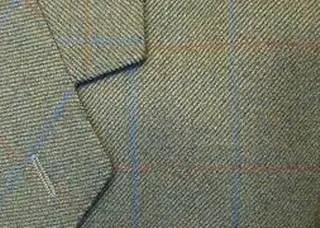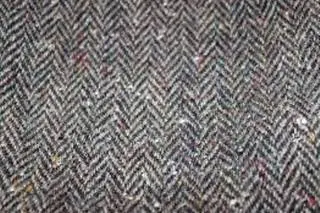Tweed fabric
Tweed fabric is a several fabric of medium-to-heavy
weight with rough in surface texture, and is produced in a great variety of color
and weave effects broadly determined by the place of manufacture. It is mainly
woven fabric. Most Tweed fabrics are
made from wool but a growing number contain a mixture of wool and cotton, wool
and rayon or wool, and man-made fibers, each giving a special property.
Generally, it is woven with a plain weave, twill, or herringbone structure.
Colour effects in the yarn are mainly got by mixing dyed wool before it is spun.
Tweed fabrics are commonly worn in both Ireland and
Scotland for outdoor activities such as shooting and hunting to withstand harsh
climates. In Ireland, tweed production is now mostly related to County Donegal
but mainly across the country. In Scotland, tweed production is most closely
related to the Isle of Harris in the Hebrides.
History of Tweed fabric
The
term tweed did not originate from the Tweed River, although the fabric was made
in the tweed valley. Tweed is normally produced by a variation of the basic
twill weave, and the old Scottish name for twill was tweel. The tweed name was
blamed for a mistake from a London clerk who accidentally wrote tweeds in 1826
while drafting an order or invoice for Tweel, a name that quickly established
itself.
Properties of tweed fabric
1.
Tweed is a rough fabric
2.
It is mostly woolen fabric.
3.
It is a very soft and open type of fabric.
4.
It has a flexible texture, resembling a cheviot, more closely woven.
5.
Generally woven is like plain, twill, or herringbone structure.
6.
It is a moisture-resistant and durable fabric.
7.
Its heat retention ability is high.
8.
Fabric breathability is low.
9.
Its fabric stretchability is low.
Tweed fabric manufacturing
The
Tweed fabric is made of tightly
woven colored wool. It comes in different weights, weaves, and colors. This
means there is no normal tweed here, the material is simple and lightweight to
colorful and heavy, covering everything in the middle of the interior. The Tweed fabric was traditionally woven by hand on the weaver. Today the whole process has been
mechanized, but the process is mostly the same. First, the raw wool is dyed and
then dried in an industrial dryer. This colored wool can be blended together to
create the right shade of thread needed for a tweet.
Types of Tweed fabric
There are different types of Tweed fabric such as below-
I. Cheviot Tweed
The
Cheviot Tweed is named after the Cheviot Hills in Northumberland and a breed of
white-faced sheep first preserved on the Scottish border. Cheviot yarn is
usually larger, rougher, and heavier than other types of tweed. It is a stiff
fabric with a certain sharpness of touch and a bright luster. Cheviot fabric is
generally suitable for indigenous wear due to its durability, and it is
suitable for urban wear due to its crease retention skills.
ii. Donegal Tweed
A
hand-woven Tweed fabric has been made in County Donegal, Ireland. Donegal has been
creating tweeds from local materials for centuries. Sheep thrive in the hills
and bogs of Donegal and provide pigment to native plants such as blackberries,
gorse, and chaff. Donegal Tweed fabric was made in County Donegal Ireland for several
centuries, this ancient craft is still alive today but several handwear in
Donegal countryside, the town of Ardara is known as the ‘Home of Donegal
Tweed’. From an early age, Mart, Dennis later acquired the building and started
his own Donegal Tweed business called Triona Design, which continues to make
clothing using Tweed fabric.
iii. Saxony Tweed
Saxony
tweed has a delicate, small pile on the face and it is very soft in touch. It
is used to produce merino-based sports jackets and the convenience of wearing
some suits. The day before, the British Bladen company had supplied a great 700
grams of Supasax tweed, which was a great part of Saxony tweed. Although the
company still exists today and still makes this tweed fabric at 650 grams made from
dense and heavy lambswool, it seems different than ever before. Also, jacket
styles are more limited. However, they have a lighter 450g version that
combines wool and bad yarns that are perfect for office wear.
iv. Sporting Tweed
Sporting
tweed fabrics were created as indigenous camouflage to help hunters blend landscape,
especially on private hunting grounds. Color combinations developed were
adapted to find the most effective combinations. For example, a local weaver
produced eight different varieties for the Strathconon Estate to prove what was
less visible before the hunters were listed. Tweed’s estate sporting background
is the primary reason for the many variations of our patterns and colors today.
v. Thornproof Tweed
A
thornproof tweed is woven with high twisted fiber to make the fabric stiff and
resistant to tears and punctures. It was first used in Canada's Red River
Rebellion in 1870, where soldiers wore a cloth made to resist thorns.
Thornproof is usually a plain, solid-colored light gray-green fabric but also
available with a windowpane. An interesting feature of the practical Thornproof Tweed,
which is very effective for hunting or mountaineering through thick
underbrushes, brambles, and gorse, is that it is a self-repairing cloth. If you
push a sharp-pointed object through the cloth to make a hole, all you have to
do is massage the cloth between your thumbs and the hole will disappear.
Vi. Harris Tweed
The
well-known brand Tweed is of course, Harris. Harris Tweed has an open, loose
twill weave that is rough to touch. First woven in the Outer Hebrides by
artisans in the 18th century, it was introduced to the British aristocracy in
1840 by Lady Dunmore. To control and protect the fabric against imitation, the
Harris Tweed Orb Certificate sign was created in 1909 - its oldest British sign
- by definition, only woven tweed in the Outer Hebrides will be eligible. The
use of the name was protected and only 100% wool-shaped hand-spun and
hand-woven products were allowed to the Outer Hebrides using the Harris Tweed
trademark.
Uses of Tweed fabric
1.
Tweeds are generally used for upper-class country clothing like shooting
jackets.
2.
Due to its durability, tweed is famous for Norfolk jackets and plus-fours are a popular choice for hunters, cyclists, golfers, and early motorists.
3.
Long-established British and American land-owning families wear high-quality
heirloom tweed that is inherited from their grandparents.
4.
Cyclists may wear tweed when they ride vintage bicycles.
5.
Tweed is used for outerwear and casual jackets.










0 Comments